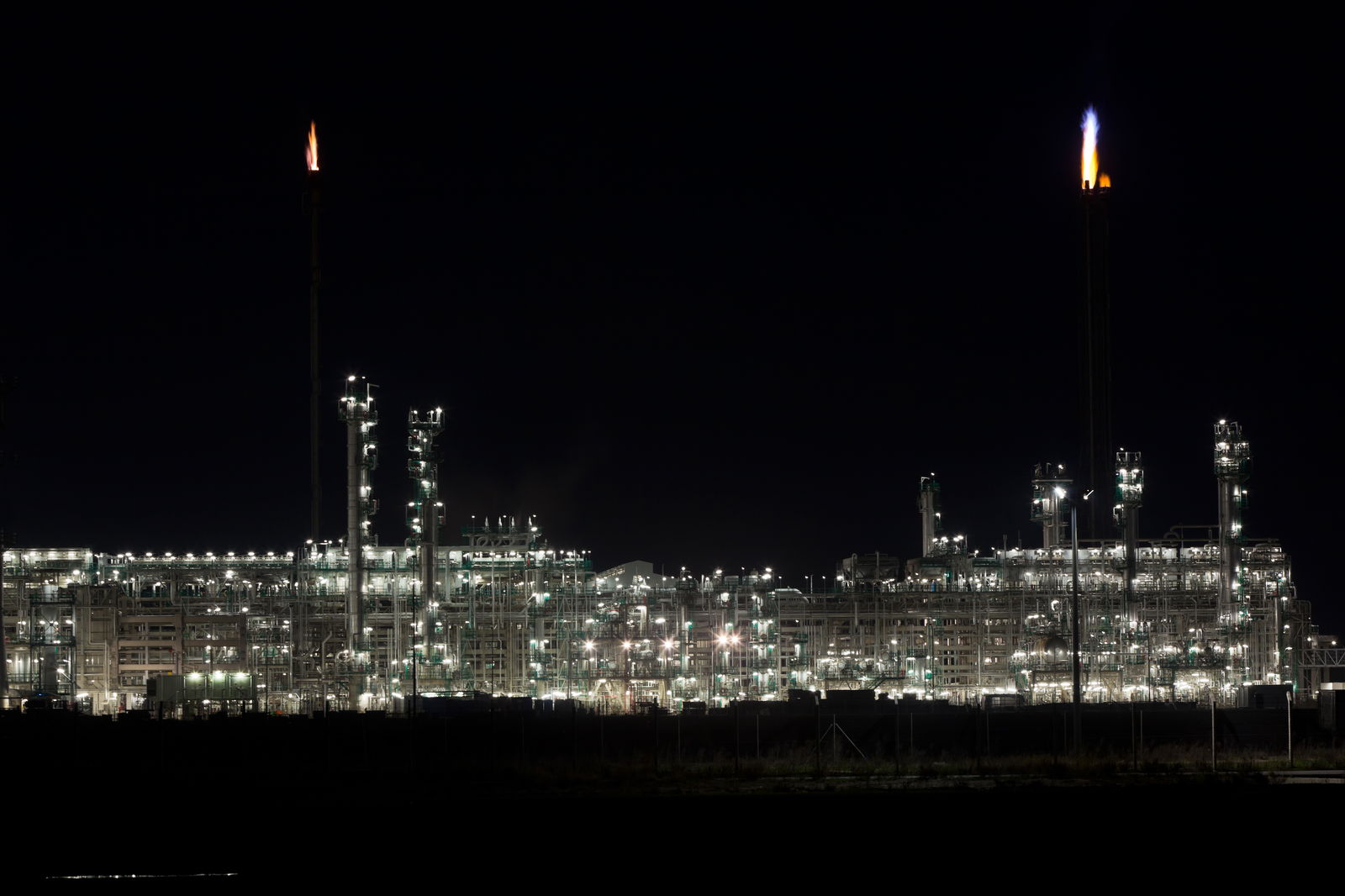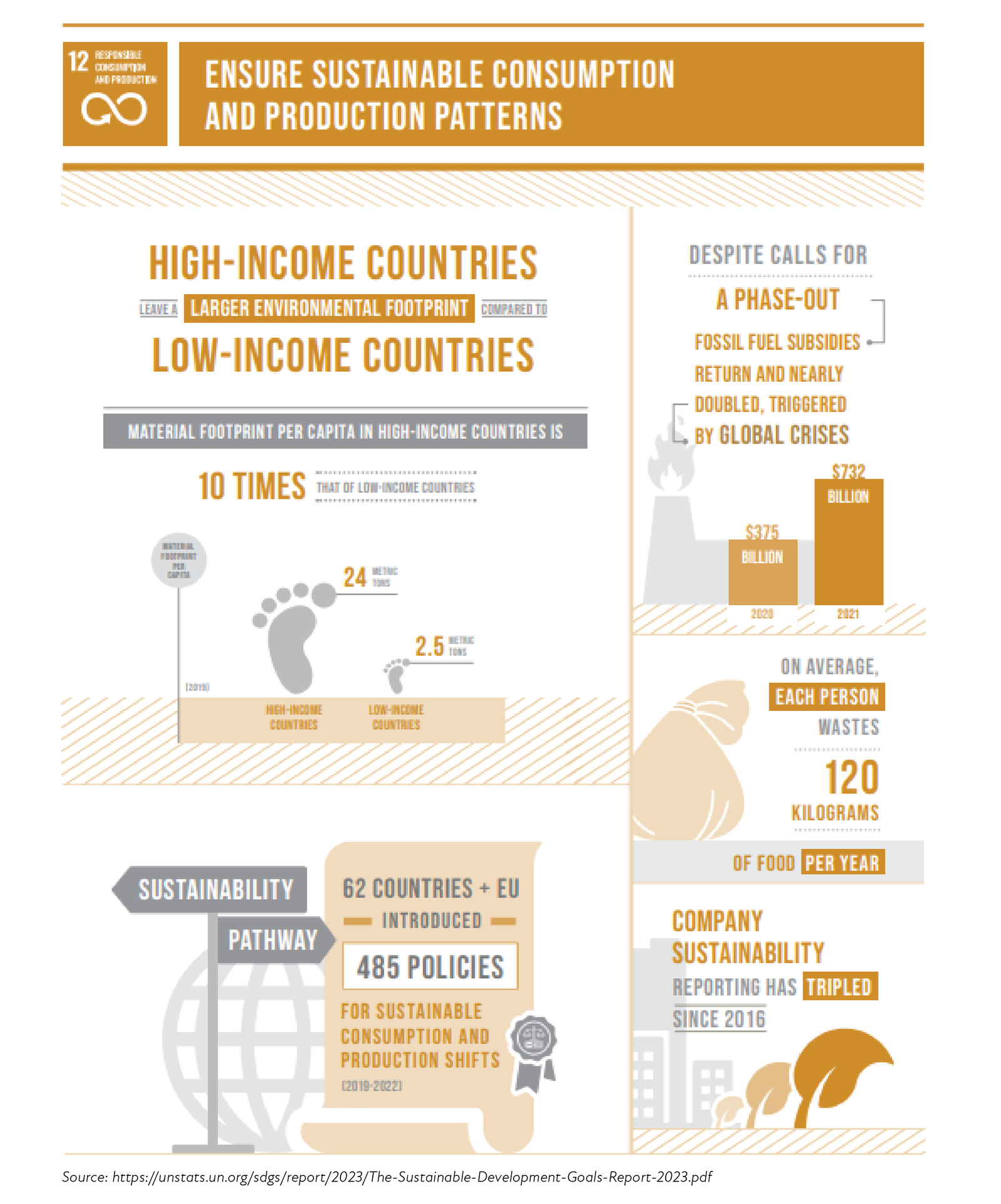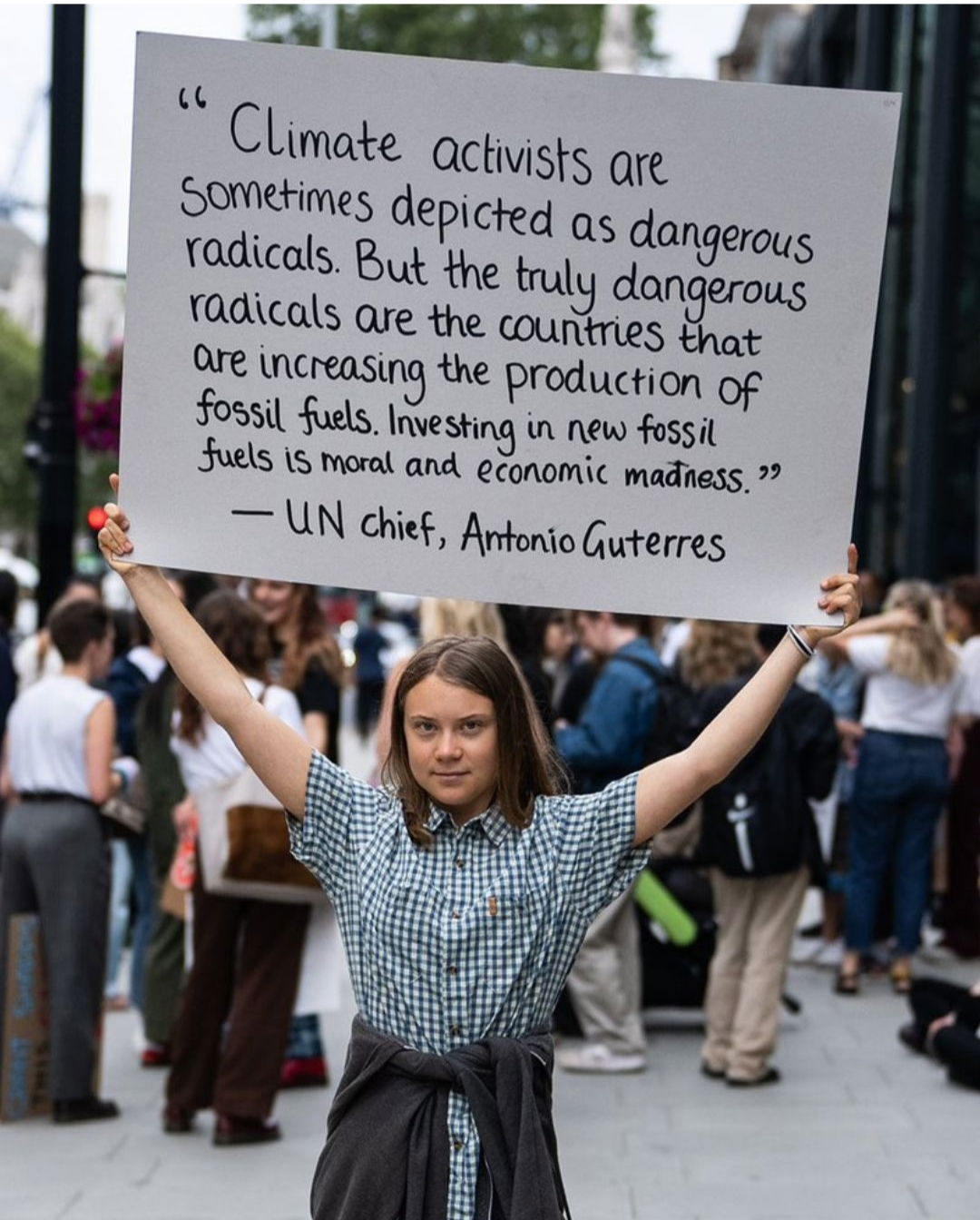Overconsumption results in climate change, biodiversity loss, and pollution


· 10 min read
Figure 1. Night view of an oil refinery plant

We’re halfway through the time the world granted itself to achieve the 2030 Agenda on Sustainable Development. To quote the UN’s Secretary-General: “…just 12 percent of the Sustainable Development Goal targets are on track.”
If we zoom in on SDG 12 (Ensure sustainable consumption and production patterns), we can only watch with sorrow as the targets are not on track. It’s extra painful since in 2002, at the World Summit on Sustainable Development (WSSD), sustainable consumption and production was identified as one of the three overarching objectives of, and essential requirements for, sustainable development, together with poverty eradication and the management of natural resources in order to foster economic and social development.
Overconsumption, defined as using too many natural resources too quickly and inefficiently, has resulted in a triple planetary climate change crisis, biodiversity loss, and pollution. Between 2000 and 2019, per capita material footprint consumption increased substantially, reaching 95.1 billion metric tons1. While global production and consumption will inevitably equal, data diverge at the regional and national levels, with the Global North having more giant consumption footprints. At the same time, the world produces a large amount of waste. Approximately 14% of food is lost in manufacturing, while 17% is lost in retail and households.
Other types of trash include poorly handled electrical and chemical waste. According to projections, the world would generate 3.40 billion tons of solid garbage annually by 20502. Continued fossil fuel subsidies have also aided unsustainable resource use. Plastic pollution has increased significantly in recent decades, reaching 400 million tons annually, and is expected to quadruple by 20403. The COVID-19 epidemic increased demand for single-use plastics, exacerbating the already severe effects on natural ecosystems and human health. The 5th United Nations Environment Assembly Session (UNEA-5.2) issued a historic resolution to eradicate plastic pollution and negotiate a legally binding international accord by 20244.
The 2030 Agenda is centered on learning to live in harmony with the Earth. Limiting damage to the climate and land and sea ecosystems will be impossible unless resources are used sustainably. According to research, up to 2015, countries tended to cross biophysical constraints quicker than social thresholds, indicating a repeating trend of environmentally unsustainable social development gains5.
Figure 2. SDG 12 infographic

While SDG 12 has eleven targets in total, the UN”s halfway report highlights two: (a) reduce domestic material consumption, and (b) remove fossil fuel subsidies. The former is judged as having limited or no progress, the latter as deteriorating.
The latter, removing fossil fuel subsidies, or, more accurately, the steep increase in it, elicited the following statement from the UN Secretary-General: “Climate activists are sometimes depicted as dangerous radicals. But the truly dangerous radicals are the countries that are increasing the production of fossil fuels. Investing in new fossil fuels in moral and economic madness.”
Figure 3. Climate activist Greta Thunberg holding a sign displaying a quote from Antonio Guterres, Sep 6, 2023, Instagram.

While the United Nations midpoint report notes a rise in fossil fuel subsidies from $375 billion in 2020 to $732 billion in 2021, the International Monetary Fund (IMF) estimates that by 2022, global fossil fuel subsidies will have reached $7 trillion, or 7.1% of GDP, an increase of $2 trillion from 2020 as governments everywhere respond to soaring energy costs by providing financial incentives.
As energy price support measures are dismantled and worldwide prices fall - a simple decision to limit production will undo this -, a reduction in subsidies may be on the horizon. But, as the proportion of gasoline consumed in emerging nations increases, these costs are expected to rise to $8.2 trillion by 2030, the target date set by the UN 2030 Agenda, resulting in the opposite of the objective.
A further undermining of the ‘SDG 12.c.1-target’ is revealed in a Sep 12, 2023 article by the Guardian, headlining that the “World Bank spent billions of dollars backing fossil fuels in 2022, study finds.”
On top, consider the following: “In Africa, fossil fuel exploitation is extremely focused on the needs of the West,” and one realizes that overconsumption by the ‘high-income countries’ is not going to end soon, on the contrary, and only points to a new round of colonial madness and inherent suffering. However, it confirms the projected increase in fossil fuel subsidies by 2030.
As mentioned before, SDG 12 has eleven targets, subdivided into a total of thirteen. For completeness, the table below shows the thirteen objectives.
Figure 4. SDG 12, targets, indicators, and descriptions

The reported halfway statuses by the UN are:
Between 2019 and 2022, 484 policy instruments supporting the shift to sustainable consumption and production were reported by 62 countries and the European Union, with increasing linkages with global environmental commitments on climate, biodiversity, pollution and waste, as well as a particular attention to high-impact sectors. Yet, reporting has been decreasing by 30% on average every year since 2019 and continues to reflect great regional imbalances with more than 50% of policy instruments reported from Europe and Central Asia.
In 2019, the total material footprint was 95.9 billion tons, close to the world’s domestic material consumption of 95.1 billion tons. The material footprint in Northern America and Europe was about 14% higher than domestic material consumption. In contrast, in Latin America, the Caribbean, and sub-Saharan Africa, the material footprint was lower than domestic material consumption by 17% and 32%, respectively.
The percentage of food lost globally after harvest on farm, transport, storage, wholesale, and processing levels, usually attributed to structural inadequacies in the countries, is estimated at 13.2% in 2021, unchanged from 2016 and far from the target of halving post-harvest food losses by 2030.
A preliminary analysis shows that around 70% of companies monitored publish sustainability reports in 2022, tripling since 2016. The sustainability indicators most widely disclosed by companies include policies on water and energy and CO2 emission, occupational health and safety, and board diversity. Companies continue to address their activities in attaining the SDGs. However, only 10% report on all 17 SDGs.
Global data showed a rise in fossil fuel subsidies in 2021 after a brief fall in 2020, which was primarily caused by a drop in energy prices. In 2021, Governments spent an estimated $732 billion on coal, oil, and gas subsidies against $375 billion in 2020. This brings the subsidies back to pre-2015 levels. High oil and gas prices in 2022 will likely bring a new increase, as subsidies are often linked to the price of energy. Please remember the IMF figures on fossil fuel subsidies.
According to the provided citations, the current improvement rates suggest that the Sustainable Development Goals (SDGs) may not be achieved by 2030, particularly in areas such as health, education, or water and sanitation, especially in regions like sub-Saharan Africa and South Asia6. The report reviews existing scenario projections and indicates that the Goals will remain out of reach by 2030 or even 2050 on a business-as-usual pathway7.
However, more ambitious sustainable development scenarios reveal that decisive action can deliver substantial gains on the Goals by 2030. For example, an ambitious “SDG-push” scenario would improve social protection, strengthen governance, promote a green economy, and address digital disruption while improving secondary education and science. By 2030, this could lift 124 million additional people out of poverty, with 113 million fewer people malnourished. It would also generate gains across other health, nutrition, and education goals.
A multifaceted strategy is necessary to achieve the goals of SDG12, as stated in the United Nations Global Sustainable Development Report 2023, Advance, Unedited Version 14 June 2023. The following methods may be used:
However, obstacles exist on the path to success, e.g., efforts to end government support for fossil fuels have stalled. Furthermore, the goal of environmentally appropriate management of chemicals and trash is still a long way off. This means that everyone involved must work harder and more consistently toward the goals of SDG128 9.
While the current trajectory is clearly insufficient to meet the SDGs by 2030, the UN posits transformative policy changes and increased ambition could accelerate progress towards these goals. The emphasis lies on could, because, realistically, can we leave the business-as-usual pathway?
To start answering that question, we will have to address the elephant in the room that is notably absent in the report and in its suggested solutions.
Consumption and production that depletes natural resources cannot be sustainable, and this requires a radical system change.
illuminem Voices is a democratic space presenting the thoughts and opinions of leading Sustainability & Energy writers, their opinions do not necessarily represent those of illuminem.
1 United Nations Department of Economic and Social Affairs. 2022i. The Sustainable Development Goals Report 2022 New York, UN DESA.
2 Kaza, Silpa, Yao, Lisa, Bhada-Tata, Perinaz & Van Woerden, Frank 2018. What a waste 2.0: a global snapshot of solid waste management to 2050. Washington, DC, World Bank.
3 United Nations Environment Programme. 2021b. Drowning in Plastics – Marine Litter and Plastic Waste Vital Graphics, https://www.unep.org/resources/report/drowning-plastics-marine-litter-and-plastic-waste-vital-graphics
4 United Nations Environment Programme. 2022b. What you need to know about the plastic pollution resolution, https://www.unep.org/news-and-stories/story/what-you-need-know-about-plastic-pollution-resolution
5 Fanning, Andrew L., O’Neill, Daniel W., Hickel, Jason & Roux, Nicolas 2022. The social shortfall and ecological overshoot of nations. Nature Sustainability, 5(1): 26-36.
6 United Nations Department of Economic and Social Affairs, 2022f.; Homer-Dixon, Thomas and Rockström, Johan, 2022.
7 Intergovernmental Panel on Climate Change, 2022d.
8 2019 Global Sustainable Development Report
9 Leininger, A. Levesque, G. Luderer, M. Pehl, C. Wingens, L. Baumstark, F. Beier, J. P. Dietrich, F. Humpenöder, P. vo n Jeetze, D. Klein, J. Koch, R. Pietzcker, J. Strefler, H. Lotze - Campen and A. Popp (2021 a ). "A sustainable development pathway for climate action within the UN 2030 Agenda." Nature Climate Change 11
Yury Erofeev

Food · Agriculture
illuminem briefings

Sustainable Lifestyle · Food
illuminem briefings

Sustainable Lifestyle · Food
Axios

Food · Sustainable Lifestyle
The Independent

Climate Change · Food
Forbes

Sustainable Lifestyle · Food